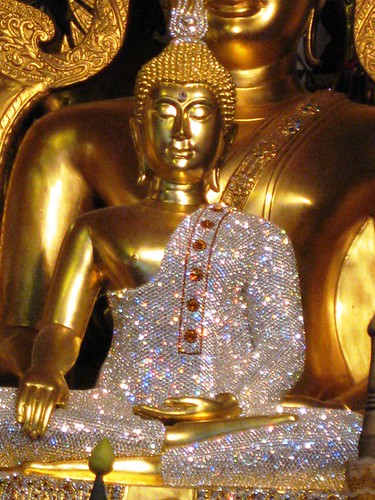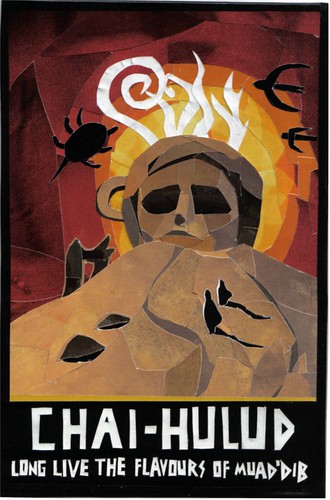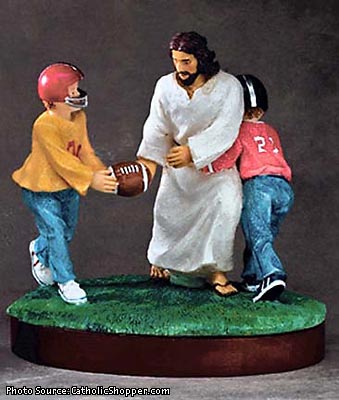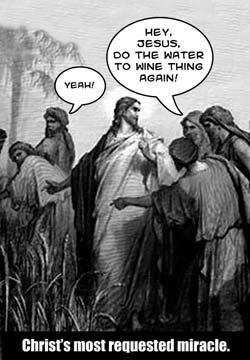-Gerard Hopkins

Fig.1 Eggs are for omelets, silly rabbit
My little cousin was raised Catholic. She went to a Catholic private school until eighth grade, serves at mass, goes to many church functions and camps and jokes about the priests’ varying sermon-giving skills with my grandma around the Easter dinner table.
One Easter Sunday we sat around and discussed the resurrection story, spun it into contemporary language, and in the end, realized that it was actually the craziest Spring Break “Disciples Gone Wild!” vacation story ever.
Just imagine Jesus explaining it to his mother:
“I don’t know what happened. One minute I was at a party, drinking with my buddies, the next, I wake up in a cave wrapped in a shroud. Then I looked at my hands and went, ‘Whoa, where the hell did those come from? And all these scars on my back and my head and this gash in my side… I swear, I had no clue what went on between Passover dinner and the cave, so I called Father and he moved the stone out of the doorway for me and went to find the guys.
“I asked Peter and Paul what happened. They were all like, ‘Dude, we thought you were dead,’ and I was like, ‘You morons!’ Son of God here! I am one with the Father and the Holy Spirit! Get with the program!
“They said that after the dinner we went to Gethsemane and got into so much trouble. Judas sold me out and the police came and arrested me and took me to trial and made me drag a cross through town and crucified me! Can you believe that? Wait, you saw all that? Holy shit. I don’t remember a thing.
“I mean, gese, listen: we came into Jerusalem, got A-list treatment at first, did some seriously awesome miracles… we were on a roll. Sure, Thomas forgot to book the restaurant I wanted for Passover, and the new place only let us all sit on once side of the table, but he came through. We were having fun! And then all this crap happened. *sigh* Tell you what. Life down here sucks. I’m out of here in 40 days. No, really, I’m gonna go live with Dad for a while. I think it’ll be the best thing for everyone.”
I apologize to Jesus for that, but I don’t think he sweats the small stuff.

Fig.3 Bad carpentry
As I mentioned above, I have Catholics in my family. My grandmother grew up on a tobacco farm in Puerto Rico and has been Catholic all her life. I’ve been to mass a few times for happy and sad functions, and my cousin, with whom I am very close, is very active in her Catholic youth groups. My brother-in-law grew closer to his Catholicism while abroad in the Army. It’s not foreign to me at all, and frankly, compared to my protestant Christian upbringing, it never seemed all that different from what I saw at the Methodist church.
Stephen Colbert showed me the difference, though. My in-depth Catholic education sprung from him, and trickled into several pools and eddies along the way.
It began with one of Stephen’s favorite guests: Father James Martin, SJ, a.k.a. “The Colbert Report Chaplain.” He first came on the show to discuss the newly discovered letters of Mother Theresa that outlined her lengthy “dark night of the soul” and struggle with her thoughts on the “absence of God” in her life. Stephen, in his uppity and ironically iconoclastic “Stephen” guise, instantly condemned her for her lack of faith and Father Martin defended her, explaining the difference between not believing in God and believing in God’s absence.
The conversation was conducted in a manner that fans have come to expect from Stephen Colbert: hard-lined but respectful. His words and reactions are almost always hard-lined on the surface, but the questions and retorts actually display Stephen’s deep understanding of and respect for religion, especially the nuances of Christianity.
Father Martin, gamely playing along with Stephen’s otherwise inflammatory inquiries, displayed that winning combination of spirituality with a sense of humor and I couldn’t resist. I went to the library and checked out his book, My Life With The Saints. With this book, he sets out to provide a bit of a primer on why Catholics revere the saints, one of the biggest sticking points in the tension between Catholicism and protestant Christianity. Written in a warm, inviting, and good-natured tone, his stories of how several different saints informed touchstones or turning points at various periods in his life beautifully revealed the great value in this tenant of Catholicism that I had never really considered before, and it inspired me more than I could have imagined.
In the book, he details his childhood, his conversion from a business career in corporate finance to Jesuit seminary, his missionary trips to Uganda and Jamaica, his pilgrimage to Lourdes and spiritual retreats, and all along the way, he is introduced to different saints’ life stories. Each story somehow corresponds with a struggle or miracle in his own life, and in this way, he befriends them, coming to know them and all their flaws and profound faith in God as close companions in his heart and soul. As a Jesuit, Father Martin interprets this experience of the saints as just another way to see God in everything, and to learn from such visions and visitations.
Fig.5 I bring you Peeps
As I read My Life With The Saints, I came to realize how much we shared in our spiritual experience. None of my saints appear on silver medallions or on prayer cards or will ever be canonized by the Pope, but in that they pop up at advantageous times in my life and help guide it toward enlightenment. Fox Mulder and Dana Scully are as good as Ignatius of Loyola and Thérèse de Lisieux. Charlie Chaplin is my Patron Saint of Creativity. Michael J. Fox is my Patron Saint of Persistence. Dr. Temperance “Bones” Brennan is my Patron Saint of Logic. Paula Deen is my Patron Saint of Indulgence. Connie and Katrina are my patron Saints of Nerdiness. Elissa Hunter is my Patron Saint of Exploration… and Manatees.
It’s a distinctly Society of Jesus trait to “love God in all things—and all things in God,” which is a challenge to see God everywhere and learn from it. It’s a lesson not unlike that of Buddhism. If God is Wisdom, Truth, and Love, then Wisdom, Truth, and Love must be sought in all things. I see them in my saints everyday.
Happy Easter!






































